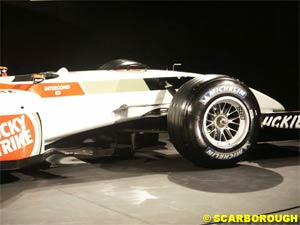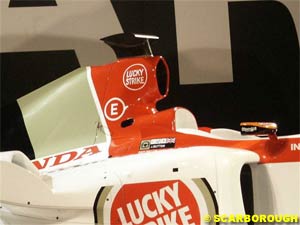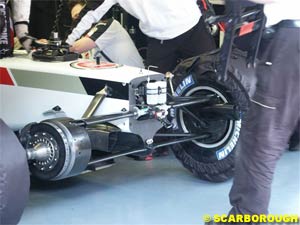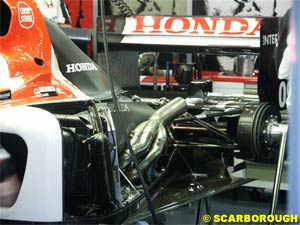
Atlas F1 Technical Writer
The BAR team now start their second year in Formula One under the existing management structure. They believe they can compete with the Big Four, but how do they propose to do this? Atlas F1's technical writer Craig Scarborough takes a closer look at the 006
Introduction
2004 could be considered the current team's second full year in F1, and the potential for 2nd year syndrome is unlikely according to Dave Richards, who sees the team as stable, well directed and mature. According to Willis, the 006 is probably about 90% of where the team want to be with the car based on sound engineering and process. He feels that any chassis unreliability is unacceptable, even if its pace still requires more time to reach the level of the top three. This belief is matched by Honda, who is adamant that the RA004 will be a frontline engine in both its size, power and reliability.
Aerodynamics
First appearances can be deceiving, as the 006 carries over a lot of the aerodynamic concept of the 005. But on closer inspection the evolution of the shape is more evident, and in some areas in advance of other teams. While Geoff Willis admitted that other concepts had been tested by their CFD teams - including broad noses such as the Williams's, and other solutions aimed at de-coupling the front wing from the nose cone - the final solution was favoured.
Willis explained that the bodywork and devices around the front of the car are more flow conditioners than downforce generators; that is, they aim to direct and improve the flow to other downforce-generating areas rather than produce downforce in their own right. Examples of 'flow conditioners' directing the flow from the middle of the front wing are the pair of small forward turning vanes, the car no longer having the r-shaped larger pair between the front wheels. Instead, a horizontal triangular plate sits within the suspension and a curled tip induced a vortex to direct the flow.
Small fairings direct the flow downwards where the wishbones mount to the chassis, keeping the flow low and aimed to pass around the sidepods. Collecting this flow up and ensuring it passes accurately under the floor and around the sidepods is the horizontal fin across the front of the sidepods, termed by Willis as either a 'flow conditioner' or more jovially as a 'water wing'.
The launch FWEPs were simple affairs with little shaping; this will see several changes over February testing and the first few races. The front wing itself is a development item; the drop plates mounting it are very short, requiring the mounts attached to the wing to be longer. This will allow the wings to be quickly switched without different nose cones. In theory a much higher flatter central wing section can be raced without installation issues.
Cooling on the car follows the flip-up duct seen in 2003, and again this year's version is highly developed; the duct protrudes almost like a chimney, allowing clearer flow around the sidepods. It is unusual in that the duct forms the sidepods to the winglet, which is primarily used to aid and direct the flow out of the duct. While the solutions look bulky Geoff Willis confirmed this is the larger option of outlet, and smaller solutions will be introduced as the cooling demands are understood.
Gearbox
BAR have been unusually open about their adoption of carbon fibre as the primary material for the gearbox structure. Eschewing their aluminium casting from 2003, the new casing echoes its shape and damper layout, but the main case is carbon fibre all the way through. While being open, the team have not gone so far as to state in what material the bearing are installed in; previous carbon boxes have used aluminium or titanium bulkheads internally to provide a very stable location for the bearings. Close up pictures form BAR's magazine show at least some type of metallic fittings is used around the differential.
Structure and Mechanicals
Other innovative areas around the chassis are the use of MMC in suspension components. The front uprights were in MMC last year, and this year sees its applications across the rear uprights suspension rocker and some other undisclosed parts. As part of the move to shift weight low and to the middle of the car the front torsion bars have been moved backwards, now being somewhat awkwardly accessed through holes in the front bulkhead.
Last year reliability issues hit the gearbox, these were not mechanical failures as such, but were related to the electronic operating them. Sensor failures lead to the computers operating the gearbox in a way it was not designed for, and hence it failed. This year more effort has gone into the wiring and control software to prevent such a failure reoccurring. Additionally the hydraulics have been overhauled and tidied; the main valve block being mounted in a well cooled position on the sidepod ducting.
Engine
Having been a major force in F1 in the eighties and nineties, Honda has failed to emerge as a serious contender in the years since their return to F1. Often cited as heavy, slow and unreliable, the engine has been another limiting factor to the BAR-Honda package. Last years saw a major step in the engine design; Honda had quietly developed an all new engine with rev ceilings and power output towards the 19,000rpm and 900bhp area.
The resulting engine is shorter, lower and lighter than the RA003e, and has matched its 2003 Suzuka spec output. Installed in the interim concept car several engines have run to 800km, a claimed first for any team. Since the initial targets have been met and the reliability proven, Honda has set about developing the engine yet further, leading to several failures in testing, all of which were pinpointed to a common part that was lightened too much as Honda pushed the envelope in the search for power.
Going into 2004, BAR have stabilised themselves in their management and technical approach. With the 006 the team believe the final pieces are in place to lead the midfield and take the fight to the top four. A wealth of clever technical solutions under a conventional skin typify the car; when matched to Honda's persistent engine development and massive resources, there is lot of promise for the team to deliver on in 2004.
 BAR have only had a short time in F1; this year sees the 006 released as the sixth car from the team. After the four initial designs coming from Malcolm Oastler working under Craig Pollock's leadership, David Richards took over just when Williams head aero man Geoff Willis was about to join the team in order to overhaul the 004 and then the technical team itself, leading to the design of the 005. While the team and car have been transformed, last year did see the same sort of form produced on track, a fact highlighted by leading in Indianapolis.
BAR have only had a short time in F1; this year sees the 006 released as the sixth car from the team. After the four initial designs coming from Malcolm Oastler working under Craig Pollock's leadership, David Richards took over just when Williams head aero man Geoff Willis was about to join the team in order to overhaul the 004 and then the technical team itself, leading to the design of the 005. While the team and car have been transformed, last year did see the same sort of form produced on track, a fact highlighted by leading in Indianapolis.
 Overall the solution is conventional, but the all-important flow under the nose has been improved by raising the underside of the chassis around the driver's legs right up to the limit that the dimensional regulations allow. This moves the lower wishbone's rear legs onto the keel and not the chassis, creating a sculpted shape above the splitter plate. The Sidepods' fronts have a rounded face and shaped inlet, leading back to the slim coke bottle shape.
Overall the solution is conventional, but the all-important flow under the nose has been improved by raising the underside of the chassis around the driver's legs right up to the limit that the dimensional regulations allow. This moves the lower wishbone's rear legs onto the keel and not the chassis, creating a sculpted shape above the splitter plate. The Sidepods' fronts have a rounded face and shaped inlet, leading back to the slim coke bottle shape.
 One aerodynamic area in its infancy on the BAR is the area on the front wing endplates (FWEPs). Since the move to Michelin, the team are trying to understand how the tyres deform when cornering. Since the tyre is in such close proximity to the endplate the requirement is totally different to the one required for Bridgestone's.
One aerodynamic area in its infancy on the BAR is the area on the front wing endplates (FWEPs). Since the move to Michelin, the team are trying to understand how the tyres deform when cornering. Since the tyre is in such close proximity to the endplate the requirement is totally different to the one required for Bridgestone's.
 Overall the rear end is quite conventional in shape and layout; the larger engine cover being cut off vertically at the axle line, while the rear wing adopts a curved 2-plane design and the endplate is cut-away behind the flap to manage the shape of the vortices being produced behind the wing. The rear wing's lower beam is not particularly shaped and the diffuser is not a Melbourne spec, the launch car not having the step in the outer diffuser channels, a practice adopted from Ferrari by Willem Toet, that allows a more aggressive angle on the roof of the tunnel.
Overall the rear end is quite conventional in shape and layout; the larger engine cover being cut off vertically at the axle line, while the rear wing adopts a curved 2-plane design and the endplate is cut-away behind the flap to manage the shape of the vortices being produced behind the wing. The rear wing's lower beam is not particularly shaped and the diffuser is not a Melbourne spec, the launch car not having the step in the outer diffuser channels, a practice adopted from Ferrari by Willem Toet, that allows a more aggressive angle on the roof of the tunnel.
 Big strides were made on the structure of the chassis last year; this year sees the new level of knowledge applied in more shape to the monocoque and its impact structures. A distinctive rollover bar and air inlet has been carried over from the 005; this was changed in mid 2003 as a result of the Honda chassis program, where a project team found a big gain in stiffness and weight with the new shape. Initially the change was believed to be related to the new engine or aerodynamic spec introduced at the same time.
Big strides were made on the structure of the chassis last year; this year sees the new level of knowledge applied in more shape to the monocoque and its impact structures. A distinctive rollover bar and air inlet has been carried over from the 005; this was changed in mid 2003 as a result of the Honda chassis program, where a project team found a big gain in stiffness and weight with the new shape. Initially the change was believed to be related to the new engine or aerodynamic spec introduced at the same time.
 Smaller mechanical changes have been to the brakes; where last year Brembo equipment was used throughout aside from the master cylinders, this year sees Alcon provide the callipers as well as the continued supply of the Master cylinders. This unusual move suggests BAR as trying to find gains on the other teams, who almost universally use Brembo or AP parts. Discs and pads remain Brembo-CCR parts.
Smaller mechanical changes have been to the brakes; where last year Brembo equipment was used throughout aside from the master cylinders, this year sees Alcon provide the callipers as well as the continued supply of the Master cylinders. This unusual move suggests BAR as trying to find gains on the other teams, who almost universally use Brembo or AP parts. Discs and pads remain Brembo-CCR parts.
 Takeo Kiuchi, who runs the Japanese based F1 project, explained that last year the final steps of the engine brought them into a competitive situation with BMW, who he sees as the benchmark engine for power and weight. Development for the 800km engine started early last year and an all new unit was developed. Unusually for a Formula One supplier this year Kiuchi made power, weight and drivability the primary requirements, with reliability being a secondary issue to be addressed once the primary issues were largely achieved.
Takeo Kiuchi, who runs the Japanese based F1 project, explained that last year the final steps of the engine brought them into a competitive situation with BMW, who he sees as the benchmark engine for power and weight. Development for the 800km engine started early last year and an all new unit was developed. Unusually for a Formula One supplier this year Kiuchi made power, weight and drivability the primary requirements, with reliability being a secondary issue to be addressed once the primary issues were largely achieved.
Please Contact Us for permission to republish this or any other material from Atlas F1.
|
Volume 10, Issue 5
Articles
Stand and Deliver
Technical Analysis: BAR 006
Technical Analysis: Renault R24
2004 SuperStats: Winter Testing
2004 Countdown: Facts & Stats
Columns
The Fuel Stop
The F1 Trivia Quiz
On the Road
Elsewhere in Racing
> Homepage |